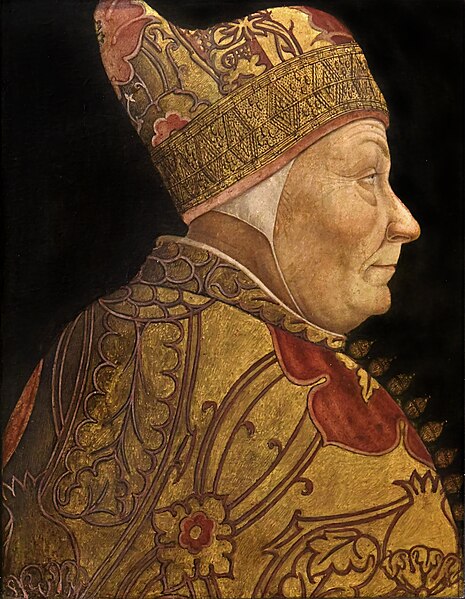A doge was an elected lord and head of state in several Italian city-states, notably Venice and Genoa, during the medieval and Renaissance periods. Such states are referred to as "crowned republics".
Leonardo Loredan (1501), Doge of Venice, portrait by Giovanni Bellini, wearing the corno ducale, the ducal hat which symbolised his office.
The Doge of Venice, illustrated in the manuscript "Théâtre de tous les peuples et nations de la terre avec leurs habits et ornemens divers, tant anciens que modernes, diligemment depeints au naturel". Painted by Lucas d'Heere in the 2nd half of the 16th century. Preserved by the Ghent University Library.
Francesco Foscari, Doge of Venice (1423–1457) by Lazzaro Bastiani
Portrait of Giovanni Mocenigo, Doge of Venice (1478–1485) by Gentile Bellini
A crowned republic, also known as a monarchial republic, is an informal term that has been used to refer to a system of monarchy where the monarch's role may be seen as almost entirely ceremonial and where nearly all of the royal prerogatives are exercised in such a way that the monarch personally has little power over executive and constitutional issues. The term has been used by a small number of authors (below) to informally describe governments such as Australia and the United Kingdom, although these countries are classified as constitutional monarchies. The term "crowned republic" may also refer to historical republics which had a doge as their head of state, most particularly Venice and Genoa, and is sometimes used to describe the current Republic of San Marino.

A 1871 caricature of the French president Adolphe Thiers by Touchatout, alluding to his 1830s defense of the July Monarchy as a “hereditary presidency”. Thiers symbolically replaces the Phrygian cap, a symbol of the French Revolution and especially of jacobinism, with a crown on a personnification of Liberty commonly used as an allegory of the French Republic.





